Searching for great virtual management software?
Managing a virtual environment is not easy.
For starters, you need to monitor things like resource distribution, security, and backup. And without a dedicated platform, it can be challenging to know the current status of any virtual machine on your network.
That’s why you need virtual management tools.
But with hundreds of apps out there, which one should you choose?
In this article, we’ll cover what virtual management software is and its key functionalities. We’ll also highlight 13 such tools available today, their features, pricing plans, and customer ratings.
This Article Contains:
(click on the links to jump to a specific section)
- What Is Virtual Management Software?
- What Does Virtualization Management Software Do?
- 13 Best Virtual Management Software
Let’s get started.
What is virtual management software?
Virtual management software is a tool that acts as an interface between a virtual environment and available hardware used to manage virtualized assets. This interface also helps provide insights to streamline the whole process.
When to use a virtual management tool?
To put it simply: when you want to manage a sizable virtual system for efficient remote work.
For example, setting up one or two virtual machines is an easy task. But if you have around 100, setting up each virtual machine can be incredibly time-consuming and tiring.
And your job doesn’t even finish then.
You need to follow up for errors and bugs with the help of project management software.
So you need virtual management software to assist you with all tasks in a virtual environment.
What does virtualization management software do?
You can use virtualization management software to manage any type of virtual resources like virtual devices, virtual servers, or any virtual system.
And while each virtual management software has its own set of functionality, most of them offer a straightforward user interface that helps with:
- Virtual machine (VM) creation.
- Virtualization monitoring.
- Resource allocation.
- Generating and compiling reports.
- Automatically enforcing rules and compliance policies.
Here’s a closer look at four key functionalities of virtual management tools:
1. Provisioning
Virtualization provisioning is the process of setting up virtualization instances of the resources you need — like configuring virtual machines.
Remember, manually configuring a large number of cloud desktops is a tedious and time-taking process. Moreover, it’ll be hard to track resource usage, storage units, and the required applications.
But with the help of a virtualization management tool, you can significantly cut down the labor required.
2. Compliance
Virtualization management software helps with integrating and enforcing compliance policies across a virtual network.
It helps with tasks like securing and monitoring systems, identifying issues, and validating user access.
For example, if you have a quarterly policy of changing system passwords in your workplace, you can monitor its compliance from one place. Instead of using an existing task management or collaboration tool to remind each user, you can view all the non-compliant devices in a single view.
Additionally, as a security measure, you can put all the accounts on hold until the password is changed.
3. Monitoring
Since virtual management software brings everything under one roof, monitoring your VMs becomes easy. You can easily monitor your network and view any type of data you want to analyze.
For example, you can manage things like:
- View all the space requirements for your machines.
- List of all the apps installed on each machine.
- Monitor the login-logout actions.
4. Operations
Operations include activities like tracking IT inventory, machine usage, discarding or reclaiming unused or underused physical resources, and investigating bugs.
Moreover, the data generated by virtual management software in handling operational tasks can help make better IT-related decisions.
13 best virtual management software
Let’s take a look a detailed look at 13 popular virtualization management tools available today:
1. SolarWinds Virtualization Manager
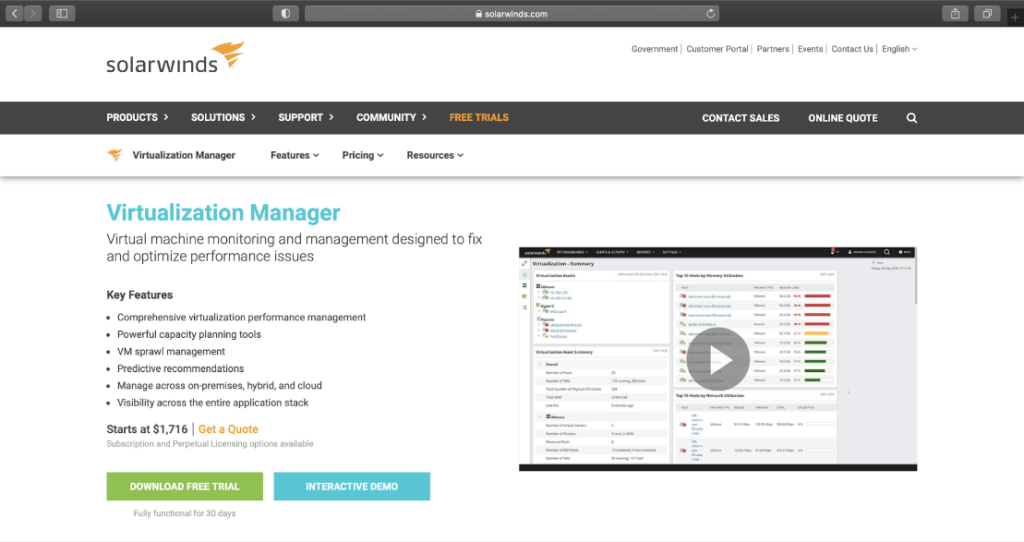
SolarWinds Virtualization Manager is a performance-enhancing virtual machine monitoring and optimization software.
It offers optimization recommendations and alerts to help you assess your virtual machine’s state and improve its functions.
Key features
- Intuitive dashboards for virtual performance management.
- Provides capacity planning tools for resource utilization optimization.
- Manage virtual machines across on-premises, hybrid, and cloud infrastructures.
- Gives you visibility across the entire application stack.
- Supports VM sprawl alerts and the ability to reclaim virtual resources.
Pricing plans
Subscription plans for Virtualization Manager start at $1716 with support for up to 8 sockets. It also offers a fully functional 30-day free trial.
Customer ratings
- G2: 4.3/5 (50+ reviews)
- Capterra: N/A
2. VMware vSphere
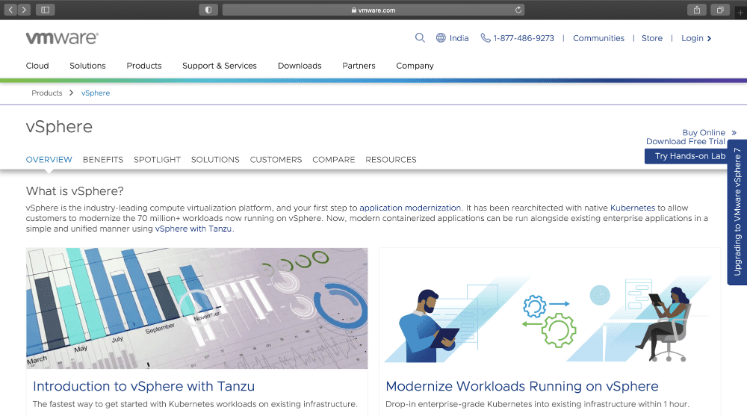
VMware vSphere is a cloud-based data virtualization platform that helps businesses manage and install virtual machines through a virtual machine manager (VMM) or hypervisor.
It also offers features like data consolidation, virtual infrastructure security, and remote support.
Key features
- Can support up to 96 hosts per cluster.
- Quickly deploy Kubernetes workloads on existing infrastructure.
- Can scale infrastructure to meet the demands of high-performance apps.
- Easily manage on-premises and cloud provider’s VMware vCenter servers.
- Offers an intuitive vSphere Client UI to submit and track feature requests.
Pricing plans
VMware vSphere plans start at $576.96 for the Essentials Kit.
Customer ratings
- G2: 4.6/5 (150+ reviews)
- Capterra: 4.7/5 (340+ reviews)
3. Veeam ONE

Veeam ONE, part of the Veeam Availability Suite, provides a monitoring and analytics solution for backup, virtual and physical environments.
It also provides reporting and automation through interactive tools, intelligent learning, identifying and resolving real customer problems before they begin.
Key features
- Offers 340+ preset alarms and 150+ pre-built reports for environment security.
- Analyze the performance of virtual and backup infrastructure objects.
- Offers clear visibility and reporting on multi-tenant environments.
- Track the efficiency of data protection in a virtualized environment.
- Generate reports and administer monitoring settings.
Pricing plans
Veeam ONE offers a free version for up to ten workloads. For the paid versions, you’ll have to contact customer support for a custom quote.
Customer ratings
- G2: 4.6/5 (140+ reviews)
- Capterra: N/A
4. Turbonomic

Turbonomic is an application testing environment that helps measure performance metrics and KPIs like compliance, consumption, system bugs, and modifications.
It also assists with resource allocation and managing deliverables.
Key features
- Gain insights into enterprise-wide Wi-Fi, routing, and switching.
- Top-down or bottom-up analytics to spot trends and anomalies.
- Can create and share dashboards with up to 13 months of performance data.
- Visualize the performance of any data center, SDN (Software Defined Networks), and public clouds.
- Offers insightful reports for app performance, VM troubleshooting, and more.
Pricing plans
Contact Turbonomic for a custom pricing quote.
Customer ratings
- G2: 4.4/5 (45+ reviews)
- Capterra: 4.4/5 (5+ reviews)
5. V2 Cloud

V2 Cloud is a desktop virtualization manager suitable for small to large-sized businesses. It enables them to host and access applications in the cloud securely.
V2 cloud offers features like multi-factor authentication, screen sharing, while-labeling, and HTTPS encryption.
Key features
- Dashboard to deploy and manage your cloud desktop infrastructure.
- Offers multi-factor authentication for users as an added security measure.
- Creates daily backups to assist in disaster recovery.
- Multi-user desktops that can hold up to 250 users on each virtual machine.
- Offers apps for Windows, Mac, Linux, iOs, Android, and Raspberry Pi platforms.
Pricing plans
Business plans start at $60/month for one user and an additional cost of $10/month per user.
Customer ratings
- G2: 4.8/5 (50+ reviews)
- Capterra: 4.9/5 (10+ reviews)
6. Densify

Densify is a cloud cost optimization and control platform for virtual infrastructures like public cloud and VMware. It balances infrastructure supply and application demand to maximize efficiency and cost savings.
Key features
- Cloud bill analysis to provide insights into spending habits and manage them.
- Analyzes service catalog offerings across the cloud to provide the best option.
- Advanced workload analysis to pick the right cloud instance for your workload.
- Ability to automate optimization for more efficiency.
- Assists in safely migrating to a public cloud.
Pricing plans
Contact support for custom pricing.
Customer ratings
- G2: 4.8/5 (5+ reviews)
- Capterra: N/A
7. Citrix Virtual Apps & Desktops

Citrix Virtual Apps and Desktops is a virtualization management solution that helps businesses enable secure and remote access to Windows, Linux, and other web applications.
It offers features like multi-factor authentication, real-time monitoring, session watermarking, and password management.
Key features
- Secure remote access to physical computers without SSL (Secure Sockets Layer) or VPNs (Virtual Private Network).
- Smart card integration to save time for employees.
- Text-based session watermark to prevent and track data theft.
- Supports server-based, highly-scalable, and multi-user virtual desktops.
- Offers secure access to Mac, Windows, Linux, iOS, Android, and web devices on the go.
Pricing plans
Monthly subscription plans start at $16/user per month.
Customer ratings
- G2: 4.1/5 (110+ reviews)
- Capterra: 4.3/5 (100+ reviews)
8. Hyper-V

Microsoft Hyper-V Server is a stand-alone product that provides a simplified, reliable, cost-effective, and optimized virtualization solution.
Key features
- Nested virtualization to create virtual machines with a hypervisor host.
- Host resources protection to protect Hyper-V resources like the CPU from being 100% occupied by one virtual machine.
- Virtual disks encrypted with BitLocker for protection from attacks.
- Production VM Checkpoints with Virtual Switching System (VSS) to create a more data-consistent backup.
- PowerShell Direct to send commands directly to the guest operating system.
Pricing plans
Contact support for custom pricing.
Customer ratings
- G2: 4.3/5 (100+ reviews)
- Capterra: N/A
9. ManageEngine OpManager

ManageEngine OpManager is a network management solution suitable for businesses of all sizes. It provides features like network and server monitoring, bandwidth analysis, configuration management, and fault management.
Key features
- Router monitoring to get insights on router performance.
- Intuitive dashboards that support 2000+ metrics, alerts, and reporting for network performance monitoring.
- Ability to monitor VoIP (Voice over Internet Protocol) call quality across WAN (Wide Area Network) infrastructure.
- Switch port mapping to identify devices connected to a port.
- Network mapping to visualize and pinpoint network outages and performance degradation.
Pricing plans
Subscription plans start at $95 with licenses for 10 devices and 2 users. It also offers a 30-day free trial.
Customer ratings
- G2: 4.5/5 (20+ reviews)
- Capterra: 4.6/5 (35+ reviews)
10. Foglight
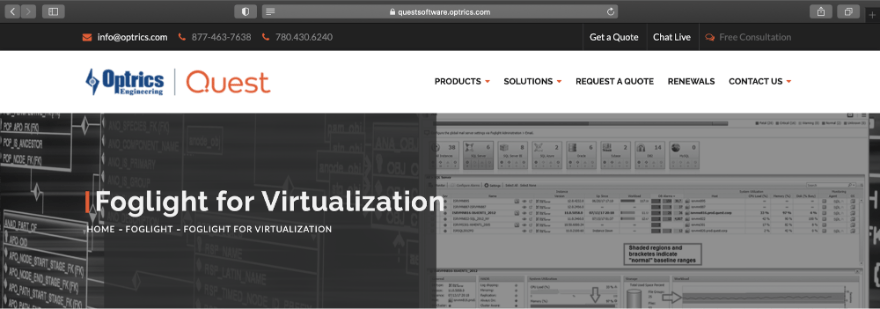
Foglight by Quest is a database performance management suite that offers modules to perform cloud analytics, network performance monitoring, and virtualization management.
It also helps with scaling to a virtualization-based monitoring solution.
Key features
- End-to-everything visualization for greater transparency of VMware and Hyper-V environments.
- Ability to visualize the performance issues troubleshoot changes to the virtual infrastructure.
- Capacity planning and resource utilization management.
- Chargeback and showback reporting for cost-optimization of data centers.
- OpenStack, VMware, and Citrix Virtual Desktop Infrastructure (VDI) monitoring.
Pricing plans
Contact support for a custom quote.
Customer ratings
- G2: 4/5 (45+ reviews)
- Capterra: 5/5 (2+ reviews)
11. vRealize Operations
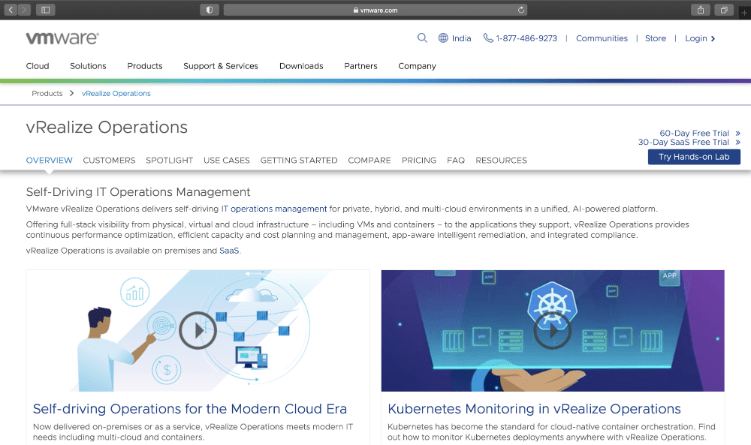
VMware vRealize Operations is an AI-powered platform that offers automated IT operations management for various virtualized environments.
It also provides features like performance optimization, capacity and cost planning and management.
Key features
- Predictive analytics for continuous operations management.
- Real-time predictive capacity and cost analytics to forecast demand.
- Cost transparency across cloud computing resources like private, hybrid, and public clouds to optimize planning.
- Support for physical, virtual, and cloud infrastructure and container platforms.
- Unified monitoring and visibility across Google Cloud platform, Amazon Web Services (AWS), and Microsoft Azure.
Pricing plans
vRealize Operations can be purchased standalone or bundled with other VMware suites — but you’ll have to contact support for custom pricing. It also offers a 60-day free trial.
Customer ratings
- G2: 4.4/5 (15+ reviews)
- Capterra: N/A
12. Workspot
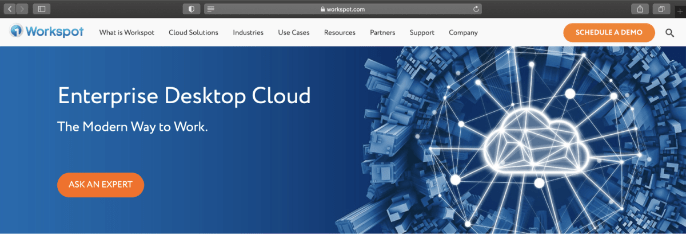
Workspot is a Virtual Desktop Infrastructure (VDI) designed for medium to large-sized businesses across various sectors like finance, healthcare, and education.
It offers a unified platform for a remote team or virtual team to manage any IT infrastructure situated across the world.
Key features
- Representational State Transfer (REST) APIs to automate the workflow of cloud PC provisioning.
- Can easily extend existing security and authentication policy to any Workspot deployment.
- Conducts device posture checks, logs compliance and auditing events, and more to ensure secure access.
- Various levels of encryption for all communication and configuration information.
- Ability to control the websites a user or IT professional is allowed to visit.
Pricing plans
Workspot plans start at $15/month per user.
Customer ratings
- G2: 4.8/5 (15+ reviews)
- Capterra: 4.7/5 (10+ reviews)
13. Red Hat Virtualization

Red Hat Virtualization, formerly known as Red Hat Enterprise Virtualization, is an open-source server and desktop virtualization solution suitable for enterprises.
Key features
- Easily automate, manage, and modernize virtualization workloads.
- Virtualizes Linux and Windows workloads to improve performance.
- Offers a single virtualization platform to perform actions like create, start, stop on VMs.
- Intuitive tools to help you automate migration from another vendor.
- Integrates with partner solutions like Red Hat Enterprise Linux and Red Hat OpenShift.
Pricing plans
Contact sales for a pricing quote.
Customer ratings
- G2: 4/5 (10+ reviews)
- Capterra: 4/5 (1+ reviews)
Wrapping up
Each virtual management software offers its own set of useful features.
Some help streamline the virtual infrastructure setup, while others offer insightful performance reports to optimize your processes.
Go through the tools we mentioned here and find the virtual management software that suits you best.
Once you’ve picked the right software, you’ll be able to handle all virtualization-related tasks without any hurdles!


